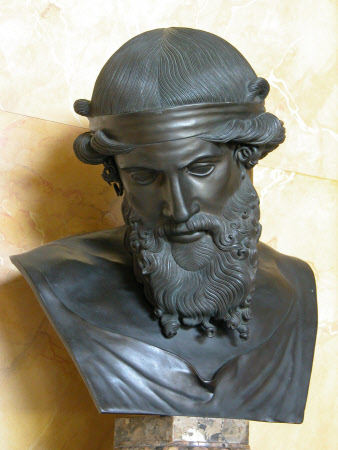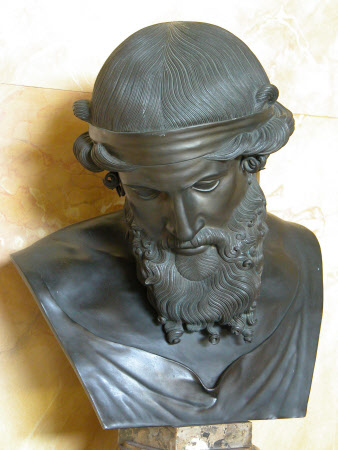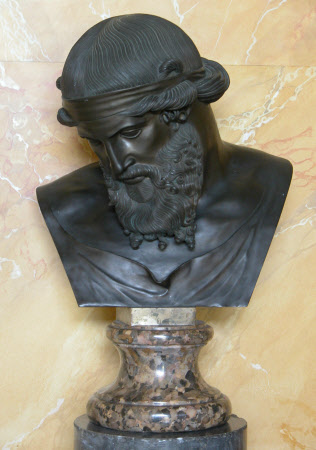Bust of Priapus, god of fertility
attributed to Sabatino de Angelis (b.1838)
Category
Art / Sculpture
Date
c. 1889 - 1890
Materials
Bronze and marble
Measurements
475 mm (H); 475 mm (W)
Place of origin
Naples
Order this imageCollection
Hatchlands Park, Surrey
NT 1166748
Summary
Sculpture, bronze; bust of Priapus; Naples, probably foundry of Sabatino De Angelis, c. 1889-90. A bronze copy of a famous bronze bust of a man found at the Villa dei Papiri in Herculaneum in 1759. Once thought to represent the philosopher Plato and then the god of wine Bacchus (Greek, Dionysus), it is now recognised to be an image of Priapus, the god of procreation, and guardian of gardens and vineyards. The full-size cast was probably made in the Neapolitan foundry of Sabatino de Angelis (1838- c. 1915), one of the best of a number of Neapolitan sculptors in the later nineteenth and early twentieth centuries, who set up bronze foundries to meet the demand for copies of famous antiquities, especially but not only those discovered in Pompeii and Herculaneum. The group of five bronze casts at Hatchlands is an impressive representative example of this fashion in the decades around 1900.
Full description
A full-size bronze copy of a bust of Priapus, showing the god with carefully combed hair and beard, the long hair looped above the ears and rolled up at the back of the neck, held in place by a plain headband (mitra). The beard is formed from spiralling curls falling onto the man’s chest, whilst there is a ‘spade’ of hair below the lower lip. He wears a chiton garment. The bust is mounted on a socle made from variegated marble. The original bronze bust of which this is a full-size cast was discovered at Herculaneum, in the Villa dei Papiri, on 18 April 1759. It quickly became one of the most admired of the sculptures excavated from Herculaneum and its sister city of Pompeii. The German art historian Johann Joachim Winckelmann (1717-68), who believed it depicted the philosopher Plato, described it as ‘one of the most perfect works in the entire world; in fact, it is among the most beautiful objects of any kind.’ The bust was subsequently thought to represent the god of wine Bacchus (Greek, Dionysus), but is now widely accepted as a portrayal of the god of fertility Priapus. The original bust from Herculaneum was made in the first century BC, in a deliberately archaic style that echoed and reflected earlier Greek sculptural styles. At this time in the Roman world, images of Priapus were popular, being associated with idealised pastoral notions of rustic simplicity, perhaps an atmosphere that the unknown owner of the Villa dei Papiri might have wanted to evoke in the furnishings of his villa. The bust is today in the Museo Archeologico Nazionale in Naples (Inv. 5618; Naples 1989, II, pp. 136-37, no. 202; Lapatin 2019, no. 36). Although it is unsigned, it is likely that like the other Neapolitan bronze casts at Hatchlands, the Priapus was produced by Sabatino de Angelis (1838 – c. 1915), whose foundry was established in 1840, presumably by his father. It became, along with the Chiurazzi and Giorgio Sommer, one of the most successful and best-known of the Neapolitan foundries, which capitalised on the huge international demand in the later nineteenth century for high-quality copies of antiquities from Herculaneum, Pompeii, Rome and elsewhere, after the Italian government had in 1860 agreed to allow the making of copies of objects in the museum in Naples. All three foundries published catalogues of the products they offered, the 1900 catalogue from Sabatino de Angelis proudly proclaiming on its cover that the firm supplied casts to various European royal houses, as well as leading museums in London, Edinburgh, Glasgow, Boston, Chicago, New York and elsewhere. In the 1870s, Sabatino de Angelis also entered into a joint venture with the rival Chiurazzi foundry, forming the Fonderie Artistiche Riunite, the main purpose of which was to cater for the burgeoning American market. It also published a catalogue in 1910, largely based on the 1900 de Angelis catalogue, suggesting that it was this foundry that provided the majority of the models for the joint venture. It certainly appears to be the case that de Angelis was especially highly regarded internationally, the American curator Edward Robinson writing in 1892 that Sabatino De Angelis was ‘by far the best of the numerous Neapolitan copyists, his talent and feeling for his line of work being rare in any generation.’ (Edward Robinson, ‘Casts for the Metropolitan Museum of New York’, American Architect and Building News, 37 no. 872, 10 September 1892, pp. 166-68, p. 167). In both the 1900 and 1910 catalogues, the bust was described as a ‘marvellous example of sculpture, one of the finest bronzes that we offer’. Like most of the models offered by de Angelis and Chiurazzi, casts could be bought in different sizes, the same as the original bust, 50 cms. high, or in smaller versions modelled in the factory, in this case 40 and 23 cms. high. It was available in two patinations, a dark-brown described as ‘Herculaneum’ or a richer and brighter colour, described in the company’s catalogues as ‘moderne’. The Hatchlands version is probably the former. The five impressive casts at Hatchlands were probably all acquired by Harry Goodhart-Rendell’s grandfather Stuart Rendel, 1st Baron Rendel (1834-1913) to furnish the entrance hall at Hatchlands, after he had bought the house in 1888. Jeremy Warren May 2023
Provenance
Presumably acquired by Stuart Rendel, 1st Baron Rendel (1834-1913), c. 1890; by descent to Harry Stuart Goodhart-Rendel (1887-1959), by whom given in 1958.
Makers and roles
attributed to Sabatino de Angelis (b.1838) , caster
References
Sabatino 1900: Catalogue illustré de Sab. De Angelis et fils, Naples, Naples 1900, p. 2, no. 5618. Chiurazzi and De Angelis 1910: Fonderie Artistiche Riunite. J. Chiurazzi & Fils – S. De Angelis & Fils. Bronzes, Marbres, Argenterie, Naples 1910, p. 2, no. 5618. Naples 1989: Renata Cantilena et al., Le Collezioni del Museo Nazionale di Napoli, 2 vols., Rome 1989, II, pp. 136-37, no. 202. Lapatin 2019 : Kenneth Lapatin, ed., Buried by Vesuvius. The Villa dei Papiri at Herculaneum, exh. cat., J. Paul Getty Museum, Los Angeles 2019., pp. 200-01, no. 36.


